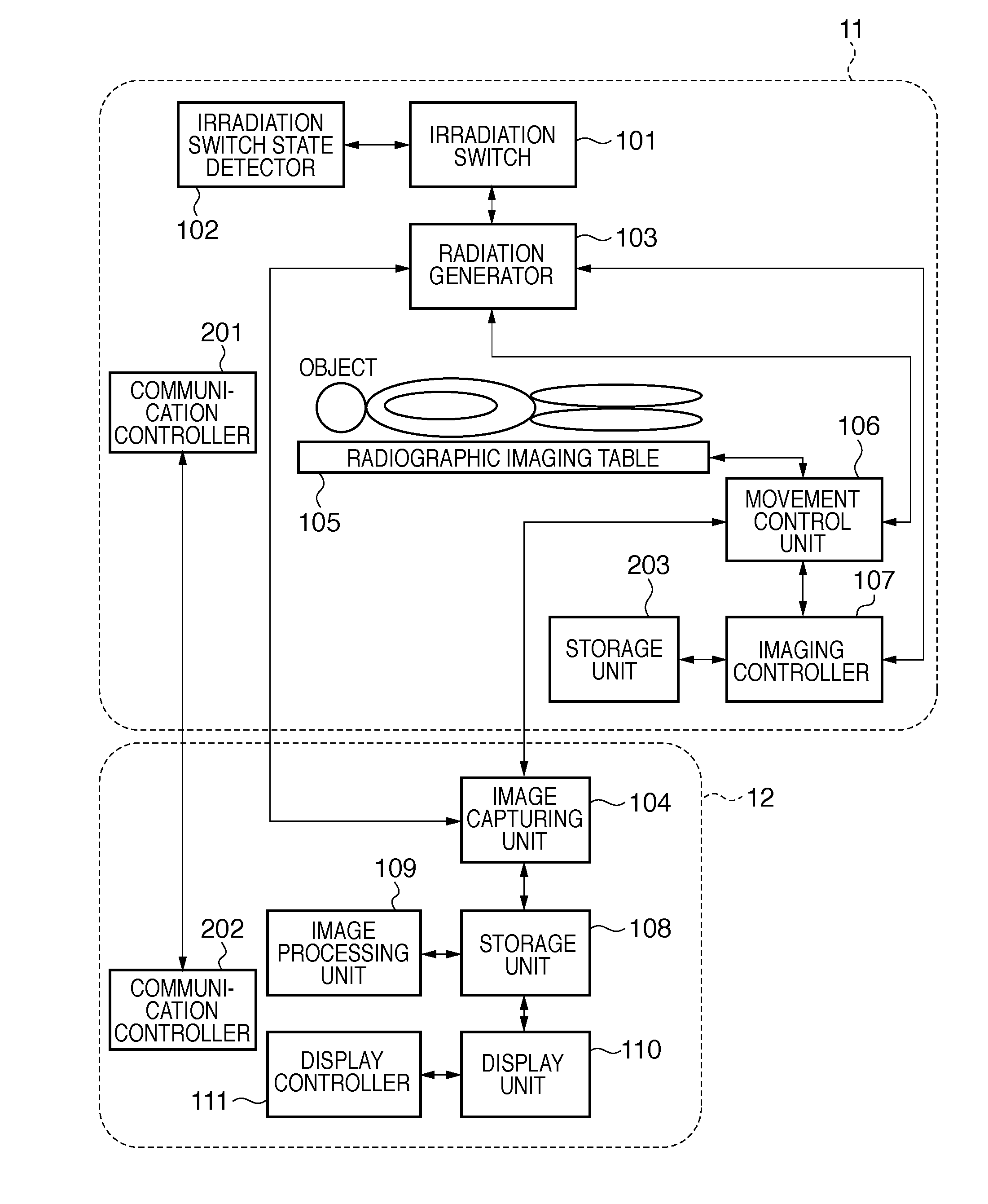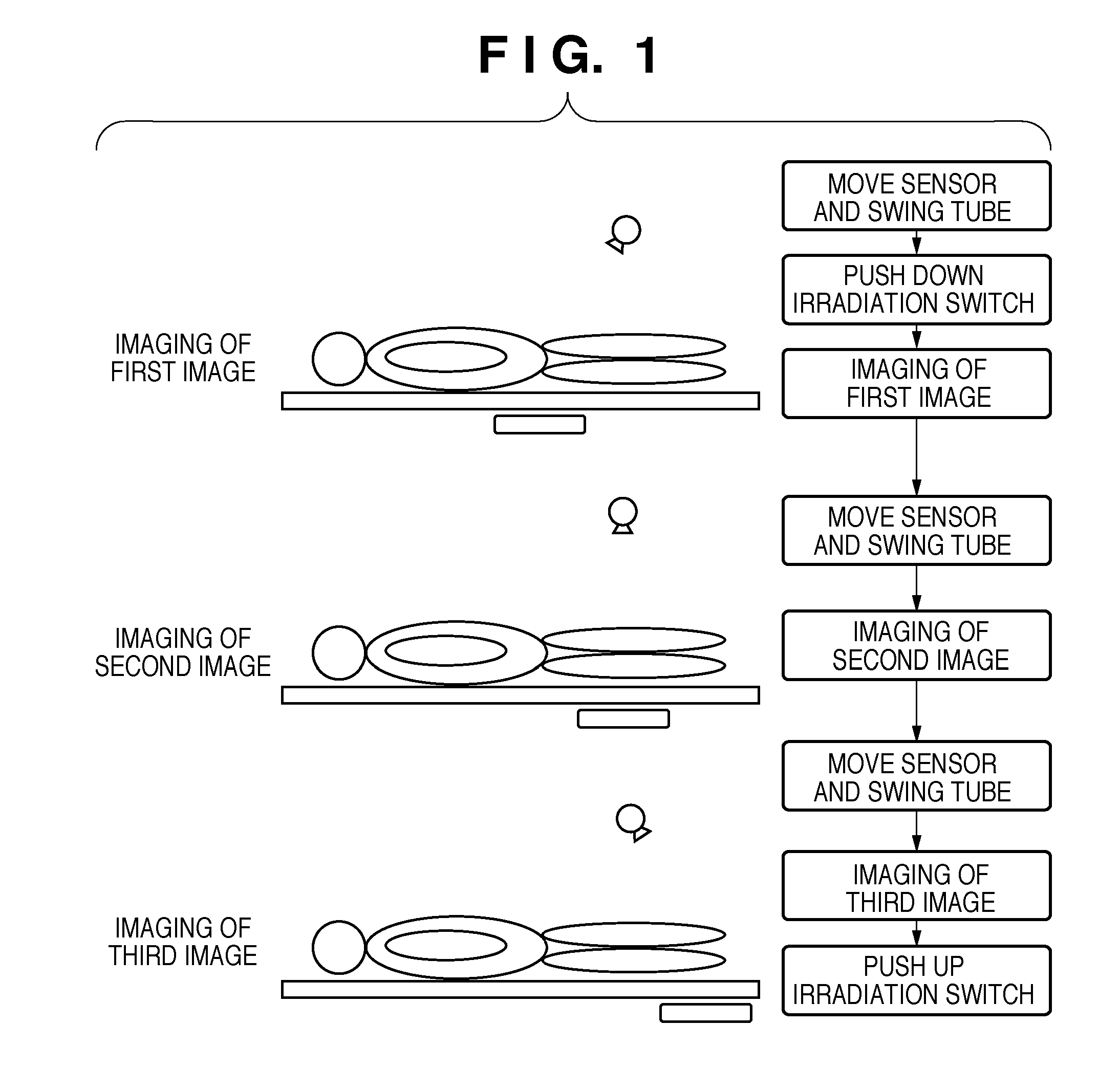Radiographic apparatus and imaging method thereof
a radiographic apparatus and imaging method technology, applied in electrical apparatus, medical science, diagnostics, etc., can solve the problems of not being able to image the entire area, generating twice the labor of the operator to perform imaging, and not being able to complete imaging, so as to avoid the effect of generating twice the labor of the operator
- Summary
- Abstract
- Description
- Claims
- Application Information
AI Technical Summary
Benefits of technology
Problems solved by technology
Method used
Image
Examples
embodiment 1
[0045]In Embodiment 1, a description will be given of a divided capture method in the configuration shown in FIG. 2.
[0046]FIGS. 5A and 5B are flowcharts illustrating a flow of a divided capture method of the present invention in the configuration shown in FIG. 2.
[0047]FIG. 6 is a diagram illustrating a radiation irradiation region.
[0048]First, in step S1, placement conditions including a radiation irradiation region for an object and the rotation angle of an imaging sensor with respect to the axis of the object, and a plurality of body parts divided for the object are determined in accordance with a designation from the operator.
[0049]Here, the imaging sensor serving as the image capturing means will be described.
[0050]FIG. 6 is a diagram illustrating a radiation irradiation region. As shown in FIG. 6, a radiation irradiation region 602 is located at the central portion of an imaging sensor 601. When radiography is performed, an actual irradiation region is narrowed by a device call...
embodiment 2
[0074]In Embodiment 2, an example will be described in which the number of times imaging implementation information indicating implementation of each imaging process has been acquired is used as a condition for determining whether or not all the imaging processes have been completed, unlike Embodiment 1 in which the index of the number of captured images is used as a condition for determining whether or not all the imaging processes have been completed.
[0075]FIGS. 9A and 9B are flowcharts illustrating a flow of a divided capture method of the present invention in Embodiment 2. In FIGS. 9A and 9B, the details of the steps other than steps S101 to S104 are the same as those of the steps described in relation to FIGS. 5A and 5B, so the description thereof has been omitted here.
[0076]In step S101, the count value (Count) indicating the number of times the imaging implementation information has been acquired is initialized to “1”.
[0077]In step S102, the imaging controller 107 compares th...
embodiment 3
[0080]In Embodiment 3, a description will be given of a divided capture method that takes into account the case where the object has moved during imaging in the configuration shown in FIG. 2.
[0081]FIGS. 10A and 10B are flowcharts illustrating a flow of a divided capture method of the present invention in Embodiment 3. In FIGS. 10A and 10B, the details of the steps other than S201 are the same as those of the steps described in relation to FIGS. 5A and 5B, so the description thereof has been omitted here.
[0082]In step S201, the image processing unit 109 determines whether or not composition processing can be performed for each imaging process. That is, if the object has moved during imaging an image, the image cannot be successfully composed during the later composition processing; accordingly, in Embodiment 3, each of the plurality of divided images is composed for each imaging process, the degree of matching between the divided images is calculated, and whether or not the degree of...
PUM
 Login to View More
Login to View More Abstract
Description
Claims
Application Information
 Login to View More
Login to View More - R&D
- Intellectual Property
- Life Sciences
- Materials
- Tech Scout
- Unparalleled Data Quality
- Higher Quality Content
- 60% Fewer Hallucinations
Browse by: Latest US Patents, China's latest patents, Technical Efficacy Thesaurus, Application Domain, Technology Topic, Popular Technical Reports.
© 2025 PatSnap. All rights reserved.Legal|Privacy policy|Modern Slavery Act Transparency Statement|Sitemap|About US| Contact US: help@patsnap.com



